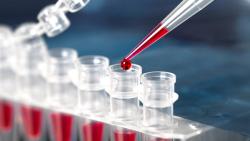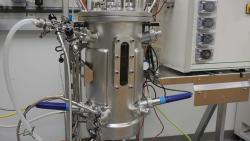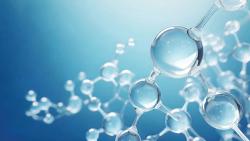
OR WAIT null SECS
- About Us
- Advertise
- Editorial Information
- Contact Us
- Do Not Sell My Personal Information
- Privacy Policy
- Terms and Conditions
© 2024 MJH Life Sciences™ and BioPharm International. All rights reserved.
A Method for Removal of Endotoxin from Pharmaceutical Formulation
The authors describe a simple method to remove endotoxins from highly viscous formulations.
ABSTRACT
In this study, strong anion exchange membranes were found to depyrogenize highly viscous formulations (viscosities 20–35 mPas, ≥ 640 mg substance/mL) of triodinated X-ray contrast agents, such as Visipaque and the Gd-chelate based MR-contrast agent Prohance, without the need to dilute the formulation. The method was simple to perform and had no impact on pH, ionic strength, or concentration of gadolinium. The applicability of the method was demonstrated on endotoxin-contaminated formulations with different ratios of Ca2+ and Na+, which remained unchanged after treatment with the anion membrane.
Working with new experimental drugs for in vivo studies requires careful control of the endotoxin content, so that any adverse effects caused by endotoxin are not superimposed on side effects from the investigational drug. The authors therefore developed a method that could give endotoxin values < 1 EU/mL without changing the composition of the drug formulation.
Lipopolysaccharide (LPS) is composed of a carbohydrate portion and lipid-A, and appears in solution as molecular aggregates between 10,000 and 1,000,000 Da. Lipid A contains phosphate groups that give the molecule a negative charge and allow use of an anion exchanger for removal (1). The common methods for removal of endotoxin (LPS) from solutions are ultrafiltration, adsorptive matrices such as chromatographic resins, and ion-exchange resins (2–4). The choice of method is dependent upon the concentration and type of drug molecule, the molecular weight, ionic strength, pH of the medium, pI, and the interaction between the drug molecule and LPS (i.e., aggregation). For highly viscous solutions, attempts to remove endotoxin by any of the common methods was unsuccessful because of long centrifugation times and clogging of the filters.
The authors identified a method that can be used as a final step directly on formulations of X-ray contrast agents with high viscosities (20–35 mPas, ≥ 640 mg substance/mL) and gadolinium-based magnetic resonance (MR) contrast agents (5).
Because most methods require diluted solutions, the high concentration of nonionic contrast agent provides an advantage by lowering the solubility of LPS in the medium and pushing this negatively charged species onto the exchanger. For research on new X-ray contrast agents such a method is of high value and has not been described in the literature. A search in Scifinder retrieved only one publication describing the removal of endotoxin from pharmaceutical formulations with high viscosity (6).
MATERIAL AND METHODS
Samples
Tri-iodinated aromatic X-ray compounds: Visipaque (Iodixanol 320 mg iodine/mL in 10 mM TRIS buffer pH 7.4, osmolality adjusted to 290 mmol/kg with NaCl, viscosity = 24 mPa) was used as well as several other chemically related derivatives formulated to > 320 mg I/mL having viscosities in the range 24–35 mPa.
Gd-chelates for MR: Prohance (Gd-DOTA, 0.8 M in 10 mM TRIS buffer pH 7.4, osmolality adjusted to 290 mmol/kg with NaCl) was used.
Preparation of stock solution of LPS from Escherichia Coli
One vial (10 mg, 10 e7 EU, Sigma Corp., USA) was added to 10 mL water for injection (WFI) and 1 mL acetonitrile to give a concentration of 9.1 e6 EU/mL = 9.1 e3 EU/µL.
Preparation of working solution of LPS from E. Coli
0.1 mL of the stock solution was diluted to 10 mL with WFI (dilution factor = 100) to give 91 EU/µL.
Depyrogenation procedure
Filter device: 15 cm2 Sartobind Q15 (Sartorius, NY) membranes integrated in ready-to-use units with pore size 3–5 µm made of cellulose modified with positively charged quaternary ammonium groups.
Equilibration and sterilization of Sartobind Q15: Each filter was eluted with 50 mL 10 mM TRIS pH 7.4, followed by 5 mL 70% ethanol that was allowed to stay in the filter for 3 min, and finally with 50 mL 10 mM TRIS pH 7.4.
Endotoxin removal: The formulations were passed through the filter units by a flow of 1–2 drops/s.
Sampling for endotoxin analysis
Because of the high viscosity, it was crucial to mix the formulation thoroughly after elution through the Sartobind Q15 anion exchanger. As the absorption efficiency of the Q15 will decline rather sharply when the capacity is exceeded, a marked difference in the endotoxin level can be observed between the start and end of the removal process.
Analysis of endotoxin content
All reagents and standards were supplied by Lonza (Basel, Switzerland). The chromogenic method was used for determination of the endotoxin content with a sensitivity of 0.005 EU/mL, as described in the pharmacopeia. A dilution of 1:200 was prepared by diluting 50 µl formulation in 9.95 mL WFI, and the sample was analyzed on the kinetic QCL instrument together with a positive control. If the positive control was positive, the test was considered valid and the results were automatically calculated by the software. No endotoxin present would give a result of NMT 1 EU/mL.
Table I: Values of endotoxin, pH and Gd/Iodine concentrations of the formulations before and after treatment with Sartobind Q15. Note that the values of endotoxin are the measured ones and differ from the theoretical values cited in the experimental section.
Application to formulations containing Na+ and Ca2+
Occasionally, unintentional contamination of sterile formulations takes place. The following describes such an example where the method was used to depyrogenize formulations of X-ray agents having endotoxin levels far above values accepted for injection. The formulations were made with different ratios of Na+ and Ca2+ that were important to preserve. In addition to the equilibration and sterilization procecures described above, the anion exchange membranes were equilibrated with TRIS-buffers having the same Ca2+/Na+ ratios as the formulations. The volumes of formulations were 100 mL, and Sartobind Q100 (100 cm2 ) membrane filters having a theoretical capacity for endotoxin of 4750 EU were used.
Figure 1: The capacity of Sartobind Q15 for lipopolysaccharide (LPS) of Escherichia Coli. Comparison of the endotoxin content pre- and post-filtration with the anion exchange membrane disclose that the approximate capacity for each cartridge is around 450â460 European Units (EU). Within this capacity range the filtrate has a measured endotoxin concentration
RESULTS
Table I shows the measured values of E. Coli endotoxin before and after a single passage through Sartobind Q15. By plotting the data in a diagram, it can be inferred that a safe capacity of Sartobind Q15 membranes for E. coli LPS can be set to 450–460 EU (see Figure 1). Within this range, the filtrate has concentrations < 0.5 EU/mL, which is considered acceptable for injection into experimental animals. The process had no effect on the iodine and Gd concentration and a negligible effect on pH.
Table II: Values of endotoxin, Ca2+ and Na+ before treatment with Sartobind 100. EU is European units.
The method was successfully applied to formulations containing Ca2+ and Na+ without affecting the ratio between them (see Tables II and III).
Table III: Values of endotoxin, Ca2+ and Na+ after treatment with Sartobind 100. EU is European units.
DISCUSSION
The method was ideal for preparing experimental formulations in exploratory phase where sterility of the starting materials is not an absolute requirement. As such, the method gave us an opportunity to increase the throughput for screening of new compounds.
ACKNOWLEDGMENTS
The authors would like to thank Dr. Ivar Martinsen, GE Healthcare, for the analysis of iodine and gadolinium of the samples and Dr. Jann Vestby and Dr. Signe Marie Jensen for determination of endotoxin concentrations.
Gunnar Hagelin, D. Philos.*, is a senior research scientist and Lars Gøran Wistrand, PhD, is department manager, both in Analytical and Bioanalytical Chemistry, Research, Medical Diagnostics at GE Healthcare, Oslo, Norway. *To whom correspondence should be addressed, gunnarhagelin@ge.com.
PEER-REVIEWED
Article submitted: Oct. 04, 2011. Article accepted: Jan. 31, 2012.
REFERENCES
1. F.C. Pearson, "Pyrogens—Endotoxins, LAL Testing and Depyrogenation," in Advances in Parenteral Sciences/2, J.R. Robinson, Ed. (Marcel Dekker Inc., New York and Basel, 1985).
2. Le Greneur Soizic et al., "Procede de Depyrogenisation De Solutions De Produits de Contraste Pour Imagerie Medicale," Demande De Brevet D'Invention, Fr. Demande, 8 pp. No. publ. 2 794 996; National Reg. No. 99 07844 (2000).
3. Ervino Morandi and Angelo Gallotti, "Process for the Depyrogenation of Injectable Pharmaceutical Solutions," PCT Int. Appl. 23 pp, European Patent Organization (EPO) No. 825 879 B1 (1996).
4. S. Brown and A.C. Fuller, J. Parent. Sci. Technol. 47 (6), 285 (1993).
5. G. Hagelin and L.G. Wistrand, "Endotoxin Removal in Contrast Media," GE Healthcare, PN0971 (2010) and EP 2286887 (2012).
6. J.W. Mitchell, "Prolonged Release of Biologically Active Polypeptides," US Patent 4,985,404, Jan. 15, 1991.
Related Content:



